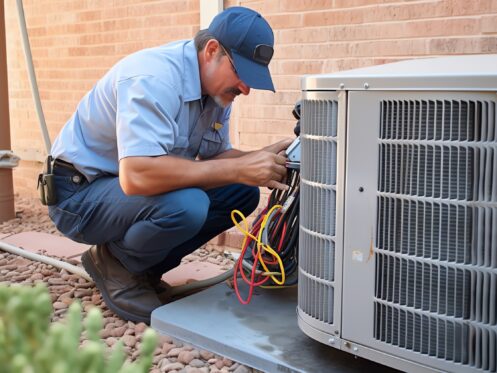Your air conditioner blowing hot air is both annoying and can elicit fear that it will be costly to repair. While both are sometimes true, the reality is that warm air coming from your vents can indicate a wide range of problems. This guide explores several common reasons why your AC may produce hot air instead of the expected cool relief.
1. Thermostat Settings
There’s always the risk of settings getting wrongly adjusted on your thermostat, especially if you have a smart model or if you live with other people. Some of the settings may affect how the air feels coming out of the vents. Start by checking the fan setting to ensure it’s set to “auto.” This only runs the fan when the compressor is running. If it’s set to “on,” it’ll continue circulating air between cooling cycles, which may feel warm compared to when it’s running. This is an exceptionally easy problem to solve at no cost.
Next, check the temperature and program settings. These may get adjusted incidentally if you’ve had a power outage, electrical surges or other power blips. If this is the case, you may want to replace your thermostat’s battery, as it is the battery that saves these settings if the primary power is interrupted.
2. Dirty Air Filter
Your air contains many contaminants that can affect how your system runs. The air filter’s job is to remove those before the air enters the system. As it does this job, it’ll get clogged and eventually restrict air flowing into your system. Restricted airflow inhibits effective heat transfer from your circulating air to the refrigerant, causing the air coming from the supply to vents to feel warmer and more humid than it should.
3. Low Refrigerant Charge
The refrigerant absorbs heat inside your home at the evaporator coil and then vents it outside through the condensing coil. However, completing the process effectively requires a specific amount of refrigerant charge in the system. Insufficient refrigerant prevents the compressor from building the proper pressure at the outside coil to vent the heat resulting in less heat absorption inside. Less heat absorption means the air isn’t as cool when it flows back into the room air.
4. Faulty Compressor
The compressor builds refrigerant pressure at the condensing coil. Increasing pressure increases the refrigerant’s temperature, allowing it to vent off the heat it absorbed inside to the air outside. Once the heat vents, the refrigerant can get cold at the evaporator coil as it expands. However, when the compressor fails to build the pressure, the refrigerant can’t get as cold as it should, which will inhibit its ability to absorb heat. Compressors often fail because of either overheating or having insufficient refrigerant in the system, both of which can be prevented with routine AC maintenance.
5. Frozen Evaporator Coil
The evaporator coil inside your home can freeze for several reasons, including insufficient refrigerant, restricted airflow, and mechanical failure. Frozen coils result in two primary issues. The first is that ice acts as an insulator, preventing effective heat transfer to the refrigerant in the coil. The second is that it restricts airflow through the coil. When the circulating air can’t transfer heat to the refrigerant, you may have less air flowing from supply vents and what does come out will feel warmer than it should.
6. Electrical Issues
Electrical problems will commonly happen at the condensing unit that will prevent your air conditioner from producing cold air. These problems usually affect the function of the condensing unit fan or the compressor. In either case, the unit can’t vent heat from the refrigerant, reducing its heat absorption capacity. Electrical issues can include damaged wiring, including damage by landscaping and yard care tools if there are exposed wires, wires chewed by animals, and loose electrical connections. Further, some of the electrical components inside the condensing unit can become clogged or damaged by insects. There may also be issues with the electrical components in the condensing coil, such as the contactor or the capacitor.
7. Condensing Unit Obstruction
In some units, the control board will prevent any part of the system from starting when there are mechanical or electrical problems. However, when the condensing unit is obstructed, the system will run, but may not produce cool air because it can’t vent heat from the refrigerant. Common restrictions include damaged coil fins, overgrown weeds or grass, landscaping structures that are too close to the unit or tree and bush branches that are growing too close to the unit. Most manufacturers recommend keeping at least 2 feet clear horizontally around the condensing unit. However, you should keep 5 feet above the unit clear to ensure the heat doesn’t stay too close to it.
8. Damaged or Neglected Ductwork
If you have a central air conditioner, you depend on the system’s ducts to transport the cooler air to the vents throughout your home. However, if those ducts have been neglected or are damaged, they may not work as well. Damaged ducts allow warm air to enter the system without flowing over the evaporator coil. Neglected ducts may transfer heat from warm areas where the ducts flow, especially if you have a crawl space rather than a full basement.
9. Insufficient Size
Air conditioners come in various sizes, where size indicates the cooling capacity of the unit. Different homes need different AC sizes based on the HVAC load, which is determined by serviceable space, home construction, insulation, amount of shade your home receives, and the number of occupants, just to name a few variables. Proper sizing is a balance of compressor capacity, duct sizing and flow and circulating fan capacity. When your air conditioner is insufficiently sized, it won’t have the capacity to absorb the proper amount of heat from your air, leaving it feeling warm as it comes out of the supply vents.
10. Control Board Malfunction
While the thermostat controls when your system cycles on and off, the control board manages all of the aspects of the cooling cycle. If the control board is malfunctioning, it may not activate the compressor or may register a frozen system. Further, if you have a modulating-stage compressor, the control board may run the compressor at a lower capacity than needed, reducing how much it cools the air cycling through it.
11. Stuck Heat Pump Reversing Valve
If your cooling system is a heat pump, this comes with unique problems compared to a standard AC. Inside the heat pump is a reversing valve that allows it to function as both a heating and cooling system. This can get stuck, and if it gets stuck in the heating mode position, it can cause hot air to flow from the supply vents. This is one of the many components a technician will test during routine heat pump maintenance.
When property owners in and around Sioux City, Iowa want heating and cooling service they can trust, they’ve turned to Kalins Indoor Comfort for more than 100 years. Our team proudly offers highly rated heating and AC repair, maintenance and installation together with duct sealing, fireplace installation and maintenance and indoor air quality solutions. Call to schedule an air conditioning repair or maintenance visit from one of our expert technicians today.











